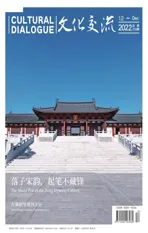风从田野来
2023-01-31文/李蔚
文 /李 蔚

1985年,杭州萧山衙前镇原交通村农户购买的12英寸西湖牌黑白电视机。当初电视机的价格360元一台,由村办交通五金厂补贴。唐志扬/摄In 1985, local residents bought a 12-inch West Lake black and white TV set in Yaqian township, Hangzhou’s Xiaoshan district, Hangzhou. The price was 360 yuan, which was subsidized. Photo by Tang Zhiyang.
艺术来源于生活。生活的源,在哪里?采风,是摄影者去捕捉画面的重要手段,也是我们寻根溯源的必行之路。
风从何处来?就在乡间地头、村前屋后、街头巷尾,就在倾听普通人的生活细节,就在我们脚踏的这片土地的最深处。“你在桥上看风景,我在桥下看你”,见微知著,让我们一起读懂生活在这片土地上人们的可爱,以及摄影者通过他们体悟到的这片土地的可爱。
生长着的乡村
过桥,一拐进杭州萧山所前镇三泉王村的地界,周国峰就张望到村委会大楼前方那片青绿园子,“这是跟企业合作的亲子菜园,上次我来时还只是一块半荒的菜园,这么快就搞好了”。
周国峰,萧山人,“玩”相机已有10多年,从去年7月开始,他和其他60多位摄影师一起,参加了“生长着的乡村”美丽乡村驻地摄影活动。
作为这次活动的成果展示,今年11月浙江展览馆曾举办了一次尤为特别的摄影展。
展览期间,一颗还挂在枝头的红心李被放大在一整面墙上,全场数它最诱人。果皮最外面,是一层粉霜,那是红心李所分泌的糖醇类物质,雾似的质感衬得果肉越发红艳诱人,而渗出的汁水恰好就停在了切面的下缘……
“这是最好的带货了。”三泉王村党委书记王海勇说,人人都知道萧山所前镇的杜家杨梅,终于轮到三泉王村的红心李了。
“一颗红心李的故事”是周国峰驻地三泉王村拍摄的主题之一,除了现场有部分展示,还被制作成了精美图册,收在三泉王村里的“乡村盒子”里。
20个村庄,有20个“乡村盒子”。
展览的首批观众中,有不少来自这20个村。随便打开一个,有村民的肖像集册,有四世同堂家庭的口述文本,有村里人家“老物件”的图集,有村植物志、建筑集,还有家家户户的水缸、民俗传说的演绎……他们没想到,有一天,长辈口中的一段记忆,日常生活中的平凡人事,乡村风貌变化的点滴,都被如此真实且详尽地以影像的方式记录下来。
策展人之一、著名摄影家傅拥军说,这样大规模的乡村影像田野调查展览在国内也是不多见的—近60多位浙江省内一线摄影师、省摄影“新峰”人才,以萧山20个村庄为样板和对象,前后耗时两年,采集和创作了5万余件乡村影像资料。
“其实盒子里也只是一小部分。”傅拥军说,他们记录下的是更广阔空间里的新时代浙江农村的新面貌、农民的新形象、农业的新成就,这是一份为新时代乡村建立的乡村档案。
红心李的故事
每年三四月,一片香雪海。三泉王村中漫山李花绽放的盛景,周国锋和他的同行们几乎一年不落,但似乎从未有摄影师好奇这一大片李树林后来发生了什么。
四月的尾巴,李花谢尽,枝头新冒出一簇簇指尖般大的青绿小果。周国峰又来了,村里转,山上钻,时不时咔嚓拍下几张。“碰到的村民都跟我说,过两三个月,一定要再来,尝尝熟透的红心李。”周国峰的好奇心就这样被勾起了。
三泉王村是中国最大的红心李集中栽种地之一。因富硒土壤,出产的红心李是全村人的自豪,“跟其他的(果子)两样煞的”。
王建传,村里的茶果栽培专家,与周国峰缘分不浅。“每次他来,都会跟着我上山拍。”上山要爬三四公里的山路。戴着村民送的草帽,周国峰背着沉重的器材,走在蝉声一片的山林小路上。
夏至时节,红心李终于熟了。“李子么,再甜能甜到哪里去?”周国峰不抱太大期望地咬下了亲手摘下的红心李,“真甜!”他终于明白,村民的自豪是多有底气了。可是,红心李其貌不扬,为了把它拍得更上照,周国锋向同行取经。有位指导老师提醒:“可以切开来嘛。”
切开来,好点子;切得好,却不易。“这一刀,切面要齐整,不能有一棱棱的割痕,那颗果子,光线也要选好,背景要干干净净的。”那位老师叮嘱道。
周国峰漫山登梯切果,试了20多颗,最后完美一刀,那颗红心李永远定格在镜头中。展览上,那颗红心李的旁边,滚动播放着“红心李的故事”。周国锋把跟随王建传上山照料果树的每个阶段,剪辑制作成了一个短纪录片。三泉王村的一大半人家,周国峰都串过门。在他的镜头里,有的村民很自然地回忆着一段历史,有的则大方地把他请进新装修好的客厅和卧室,有的还拿出几十年前在村里拍的老照片,想回到原地请他再拍一张。
“他们想拍啥,或者觉得有啥值得拍的,就会告诉我,就像叫家里人一样 。”周国峰说。
村里有位老人叫王兴发,钟爱村史研究。那次登门,周国峰本来是要给他做口述史的。替王家翻拍老相片时,周国锋从相框的背面发现了一张摄于1987年的三泉王村幼儿园全体师生的黑白合影,一问,这家人自己都忘了还留着这么一张照片。

1987年12月,杭州萧山所前镇三泉王村幼儿园,时年32岁的李仙梅老师和23位小朋友拍了这张合影(当时有24位小朋友,有一位小朋友未到)。Li Xianmei, who was 32 years old at the time, took a group photo with 23 children in her class in December 1987 at the Sanquanwang village kindergarten in Xiaoshan district, Hangzhou city.
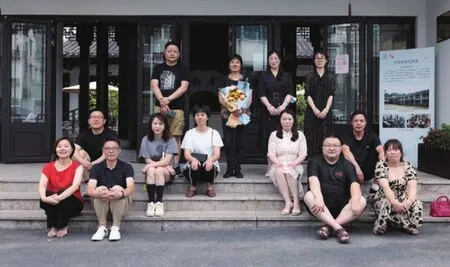
2022年6月, 时隔35年后,李仙梅老师和她曾经带过的12个孩子重聚。In June 2022, Li Xianmei reunited with 12 students she taught in kindergarten 35 years ago.
循着这张照片,周国峰辗转联系上了李仙梅老师和其中的数名孩子,能聚的都聚了,又拍了集体照。面对两张时隔35年的师生集体照,周国锋说:“我只想表达,当年的孩子像蒲公英一样散飞出去,有的落得远,有的落得近,从事着不同的工作,过着不同的生活。”
“这个村的村民,对外人总是很热情,对村里的宝贝也很珍惜,无论是一口井还是一棵树。村里年轻人也愿意回来,为村里的事出钱、出力、出点子,他们是推动这个山村持续发展和实现共同富裕的中坚力量。”周国峰越来越觉得,他的驻地采风远远没有结束。
认了个奶奶
就在周国峰还在念着要去三泉王村拍新一轮的剪枝时,浙江传媒学院在读研究生舒思维也在想念萧山灵山村青娣奶奶做的饭菜。她和青娣奶奶以美颜相机拍下的那张合影,可以说是整场展览上最温情、最可爱的记录。
“咦,我怎么戴了个东西?”青娣奶奶那句充满好奇的嘀咕,好像透着相片也能听见。
舒同学遇见青娣奶奶时,正在给灵山村的村民拍肖像。她是傅拥军带的研究生,也报名参加了这次的影像田野调查活动。老师给出的拍摄要求大纲多达12条,其中包括村庄风貌、村庄建筑、村庄植物考、村庄动物考、有代表性的村民肖像、有故事的村民家庭以及家族口述史,等等。
那是舒同学第一次前往灵山村,路上颠簸了3个钟头。一到就给村民拍肖像,一小会儿便排起了队。
轮到青娣奶奶被拍时,小舒被她的一个举动逗笑了,“她把扇子别在了后裤腰里,又用上衣盖住,从后面看,撑出了一块”。
没想到的是,就是这个奶奶,在接下来的半年时间里,成了小舒最亲密无间的人。
有一天,小舒的拍摄计划进行得很不顺,青娣奶奶看出了她的沮丧和懊恼,把还没吃饭的小舒“捡”回了家,端上一碗撒着一圈嫩绿葱花的肉馅大馄饨。而在小舒的拍摄手记里,也毫不掩饰对那碗馄饨的赞美之情,还有一句“饭吃了很多”。
在灵山村,小舒“蹭”了很多次饭。吃过村民家里的早中晚餐,老年食堂的三菜一汤,中秋节一大桌家宴,走访拍摄时还会被投喂零食、水果,甚至坐在篮球场边看比赛时,也会有陌生人突然递来一个冰淇淋。
导师傅拥军很鼓励这种与采风摄影对象同生活、共呼吸的“蹭吃蹭住”:“我们在做这20个村子的田野影像调查前,曾经对下姜村也有一个类似的采风。积累的经验是,摄影师要蹭饭吃,最好能住到村民家里去。”
小舒就这样住进了青娣奶奶的家里,奶奶专门给她准备了一间卧室。很多时候,小舒一整天都在村里边转边拍,天色一晚,青娣奶奶就会打手机来问:“苗苗,奶奶记挂你吃饭啊。”
小舒在灵山村进化成了一枚“社牛”,上到老一辈的村民,下到村里的娃娃,她可以随时随地举起相机拍下大家最自然的状态,也可以随意轻松地在村民身边坐下,听他们聊天。
小舒说,她最喜欢灵山村的,不仅是这里的朴实与良善,还有那一股极强的自我驱动力。“不少村民经济富裕了,就想着回来建设自己的家乡。就像村里的老年食堂,是他们自己捐建起来的……”
中秋节那天,小舒和村里人一起赏月聊天,有一瞬间的恍惚,好像自己就属于这里—“我的家乡在湖北广水,那里也有一个灵山村”。
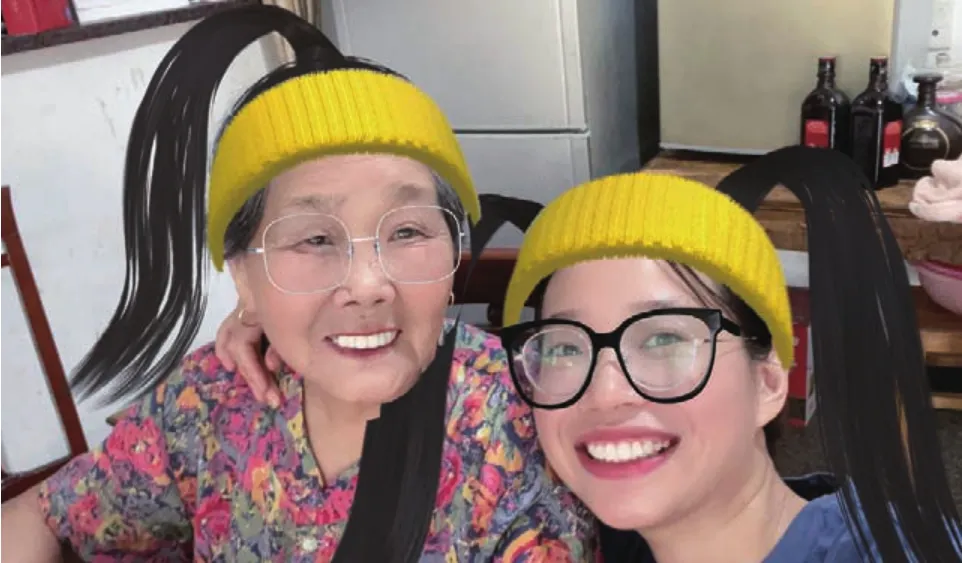
小舒在杭州萧山浦阳镇灵山村与青娣奶奶合影。Xiao Shu takes a photo with Grandma Qingdi at Lingshan village, Xiaoshan district, Hangzhou city.
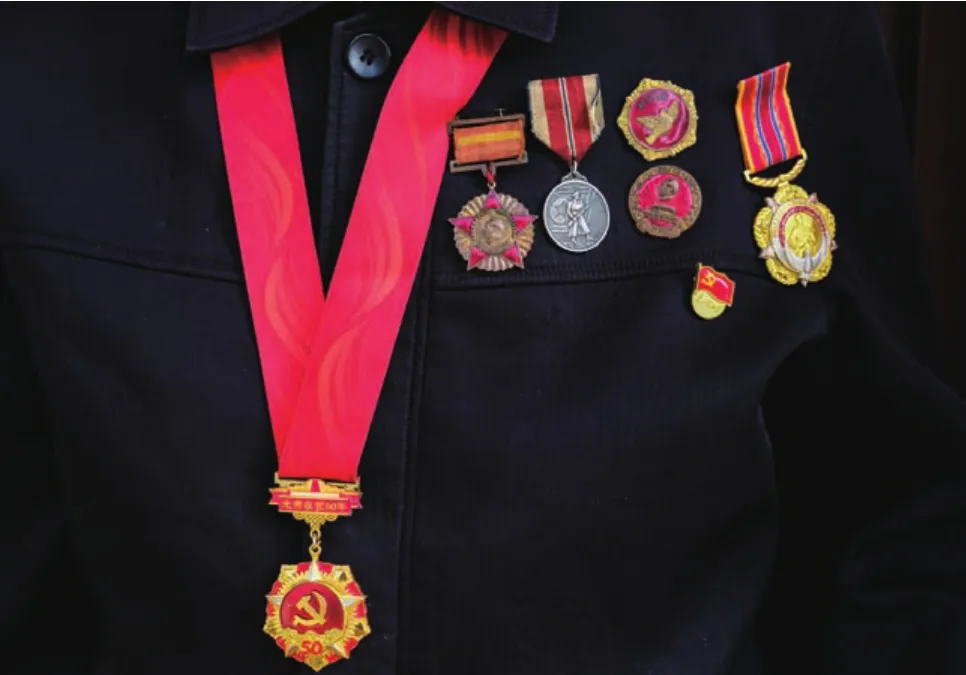
杭州萧山楼塔镇大同二村抗美援朝老兵俞关堂的珍藏徽章。楼颖/摄The military medals that Yu Guantang, a veteran who took part in the War to Resist US Aggression and Aid Korea, collected at his home in Datong’er village,Xiaoshan district, Hangzhou city. Photo by Lou Ying.

杭州萧山光明村村民动物园内的马。A horse is seen in the Villagers’ Zoo at Guangming village, Xiaoshan district,Hangzhou city.
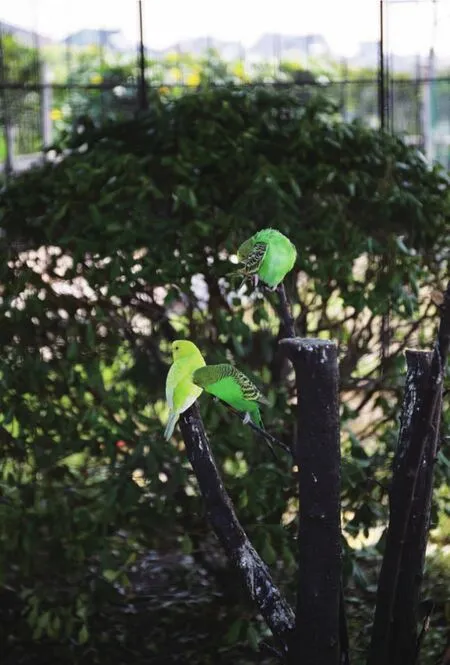
杭州萧山光明村村民动物园内的黄绿鹦鹉。Three parrots are seen in the Villagers’ Zoo at Guangming village, Xiaoshan district, Hangzhou city.
“我太久没有回去了,或许它也正在美丽起来。我能听见它在呼唤我。”那一刻,小舒也很想转身拥抱自己的故乡。
“种”进村子里
展览现场的一块图板上,再现了策划人傅拥军在活动微信群里发的一份关于拍摄的“作业大纲”。他鼓励摄影艺术家们注重个人化的观察、记录和创作,同时还列出了参与村庄影像档案拍摄必须完成的13个项目。
“这不是一般的采风,是很深入的田野调查。我当过记者,但如果以前当记者时就懂得用这种方法去做一些采访主题,应该会更好。”傅拥军总结道。
田野调查要求调查者一步一步地真正融入到调查对象中去。唐志扬也是一名当地摄影师,这次回归到老家的亲戚朋友中,作为一个调查者,严谨地采集记录,对一个采访对象的深入研究甚至要三番四次登门,挖掘出他们身上更多故事的细节。他觉得,这一回,自己才算是真正“种”进了这个村。
像孙杨洋这样的年轻人,则把镜头对准了萧山光明村村民最爱的动物园。她住进村里,跟动物管理员丁大叔结了忘年交,蹭饭的同时,听饱了一肚子村民与动物园里小动物们的故事。
“从关于动物园的各种故事里就可以感受到在这个村庄生活的老老小小的幸福感。”镜头下,小动物的安详、亲切,村民们的岁月静好,深深感染了她。
经历了这次活动,很多摄影师的成长变化很大。其中,很多人是第一次以做影像档案的方式来完整、全面、立体地拍摄一个村庄。
深入田野的驻地创作,有一种独特的强大的联结能力。“我们这60位摄影师拍下的乡村之所以‘美’,是因为它的美落在现实,不是一种面子上的美,这种美是融入了它的生活、记忆与思考,是有滋有味、有呼吸的。”傅拥军说。
乡村是中国的根基,是乡愁的寄托。以影像的方式调查、记录、留档,这种影像不单单是影像,更是一种介入现实的力量,足以激发乡村振兴的潜能。
Life Comes from the Fields
By Li Wei
Art comes from life. But where does life come from? For photographers, taking pictures out in the field is a necessary path to trace the source of life.
Zhou Guofeng, a native of Xiaoshan, has been “playing”with his camera for more than 10 years. Since July last year, he has participated in a location photography activity called “Growing Village”, together with more than 60 other photographers.
The fruits of this activity were especially exhibited in the Zhejiang Exhibition Hall in November this year. In the exhibition,a picture of a red heart plum hanging on a branch was enlarged to occupy the entire wall surface, and it was the most eye-catching of all.
“This is the best sales advertisement,” said Wang Haiyong,secretary of the party committee of the Sanquanwang village.
“Story of a red heart plum” was one of the themes for the photography activity carried out in the Sanquanwang village,where Zhou was located. In addition to the on-site display, the photos were also made into a beautiful album and collected in Sanquanwang’s “village box” — there were 20 boxes in total, one for each village.
Fu Yongjun, one of the curators and also a famous photographer himself, said that such a large-scale exhibition of rural images and field investigation findings is rare even on a national level —after all, it was a collection of more than 50,000 pieces of works including images and other forms, made by 60 and odd top Zhejiang photographers who spent two full years field investigating 20 villages in Xiaoshan.
“In fact, the boxes are only a small part of the findings,”Fu said. What they recorded is actually broader in meaning: the new looks of Zhejiang’s villages in the new era, the new image of farmers, the new achievements of agriculture... they are rural archives of the new era.
Every year from March to April, the Sanquanwang village would embrace a sea of fragrant snow flake-like plum flowers. For Zhou and his peers, the grandeur of plum blossoms is a yearly must-see, but it has never occurred to them to find out what would happen after the blossoms fail — at the end of April, the plum blossoms would fade, giving way to new clusters of fingertipsize green fruits.
Zhou came again once at this time of year, wandering around the village and climbing up the mountains while taking a few shots. “The villagers I met all told me to come back and try the ripe red heart plums in two or three months,” said Zhou, whose curiosity was thus aroused.
The Sanquanwang village has one of the largest concentrated planting areas of red heart plums in China. The plums produced from the selenium-rich local soil are the pride of the whole village.
Wang Jianchuan, the village’s tea and fruit cultivation expert,has developed a special bond with Zhou. “Every time he comes, he will follow me up the mountain to shoot.” The winding mountain road is three or four kilometers long. Wearing a straw hat given by the villagers, Zhou carried heavy equipment on his back, trudging along the mountain paths amidst the sound of cicadas.
At the summer solstice, the red heart plums would be finally ripe. “How sweet could these plums be?” At first, Zhou did not expect much. But as he bit into the fruit, he instantly understood where the villagers’ pride came from. “That is so sweet!”
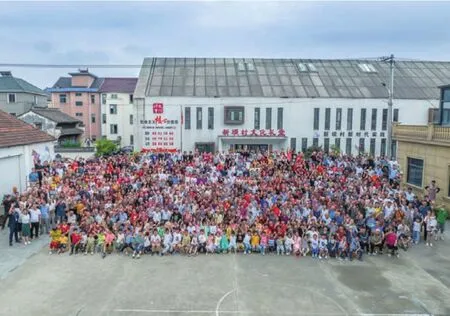
杭州萧山义桥镇新坝村村民集体大合影。徐国庆/摄Residents take a group photo at Xinba village, Xiaoshan district, Hangzhou city.Photo by Xu Guoqing.
However, the red heart plum does not look as good as it tastes.In order to make it more photogenic, Zhou also sought advice from his peers. “Why don’t you just cut it open?” someone suggested.
Good idea, but not easy to execute. “The cut should leave a neat surface without scars, and the lighting should also be strictly set to create a clean background,” he explained. Zhou then tried more than 20 times before he finally made a perfect cut, which was forever fixed on the camera. The story of the red heart plum was later made into a short documentary, placed next to the picture in the exhibition.
In the Sanquanwang village, Zhou visited more than half of the households. “They told me straightly what they wanted to shoot, or what they thought was worth shooting, like I was family,” Zhou said.“The villagers are always hospitable and caring to their treasures,whether it is a well or a tree. Young people are also willing to come back and contribute money, efforts, and ideas to their hometown.They are the backbone of promoting sustainable development and achieving common prosperity for this mountain village.” Zhou starts to feel his photography mission here has just begun.
Just when Zhou was still thinking about going back to the Sanquanwang village to shoot a new round of pruning, Shu Siwei,a graduate student at the Communication University of Zhejiang,was also thinking about the meals cooked by Grandma Qingdi in the Lingshan village. The photo she took with Grandma Qingdi with her beauty cam is arguably the warmest and cutest record in the whole exhibition.
When she first met Grandma Qingdi, Shu was taking portraits of Lingshan villagers — she was a graduate student supervised by Fu Yongjun and also signed up for this location photography activity.
It was Shu’s first trip to Lingshan village, a three-hour bumpy bus ride. As soon as she arrived, she began to take portraits of queued-up villagers. When it was Grandma Qingdi’s turn to be photographed, Shu was amused by a move of the old lady.”She put her fan in the back waist of her pants and covered it with her blouse, and from the back, it looked like something was propped up,” Shu recalled.
What Shu didn’t expect was that this grandmother, in the next six months, became the closest person to her. In the Lingshan village, Shu was treated to a lot of free meals — in villagers’ homes,in the senior citizens’ canteen, at family festival feasts... and was also fed snacks and fruits by villagers when she was shooting.
Her supervisor encouraged this kind of “hobnobbing”: “Before we did the field image survey of these 20 villages, we had a similar hobnobbing in the Xiajiang village. From my experience, the best way to get free meals is to live in the villagers’ homes.”

杭州萧山河上镇东山村村民以地方非物质文化遗产“背马纸罗伞”为主题,演绎三国的故事。詹逾/摄Villagers perform the stories of the Romance of the Three Kingdoms using “paper figurines on horse”, an intangible heritage in Dongshan village, Xiaoshan district,Hangzhou city. Photo by Zhan Yu.
That’s why Shu chose to stay with Grandma Qingdi, who prepared a bedroom especially for her. Many times, when it was getting dark and Shu was still out in the village taking pictures,Grandma Qingdi would give her a call: “Miaomiao, come back for dinner.”
According to Shu, what she likes most about the Lingshan village is not only the simplicity and goodness of the place but also the extremely strong self-driven force of the villagers.
On a board at the exhibition site, the curator Fu reproduced a “homework outline” about the shooting activity. He encouraged the photographic artists to focus on personalized observation,recording, and creation, and also listed 13 projects that must be completed for shooting the village’s image archive.
“It’s not a regular photo shoot but a very in-depth field investigation. I was a reporter before, but if I knew how to render some interview themes in this way, I would have done better,” Fu concluded.
There is something unique and powerful connecting the photographers with the fields they went deep into. “The beauty of the villages captured by our 60 photographers lies in reality.It is not on the surface but is integrated into the villages’ lives,memories, and thoughts, delightful and vivid,” Fu said.
Villages are the root of China and the harbor of nostalgia.Through images and videos, they have been investigated, recorded,and archived. Such materials also have the power to influence reality, which is sufficient to stimulate the potential of rural revitalization.
